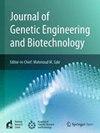孟加拉国和全球肺炎克雷伯菌ST48菌株抗生素耐药性和毒力的基因组特征和比较分析
IF 2.8
Q3 Biochemistry, Genetics and Molecular Biology
Journal of Genetic Engineering and Biotechnology
Pub Date : 2025-08-18
DOI:10.1016/j.jgeb.2025.100557
引用次数: 0
摘要
肺炎克雷伯菌是一种与医院感染相关的机会性病原体,以其耐多药(MDR)和生物膜形成能力而闻名。ST48是一种特别令人担忧的序列类型,是与全球传播和耐多药感染有关的新兴国际克隆。本研究利用全基因组序列数据对当地和全球肺炎克雷伯菌ST48菌株进行了全面的基因组流行病学研究。我们对一株肺炎克伯菌S3C进行了表型和基因型鉴定,并对孟加拉国当地ST48菌株进行了分子流行病学分析,随后对全球397株ST48菌株进行了泛基因组和系统发育分析。S3C菌株对19种测试抗生素中的17种具有耐药性,是中等生物膜前产物。全基因组测序鉴定为ST48克隆型,具有13个获得性耐药基因、76个毒力相关基因和多个可移动遗传元件。对孟加拉国ST48菌株的比较分析表明,耐多药基因(特别是blaCTX-M-15)的流行率很高,并且与生物膜形成、铁载体产生、荚膜生物合成等相关的多种毒力因子。对孟加拉ST48菌株进行泛基因组分析,共发现8030个基因,其中核心基因占56.26%。相比之下,全球ST48菌株共有16307个基因,其中75.3%为辅助基因,显示出广泛的基因组可塑性。系统发育分析显示,来自不同地区的分离株聚集在主枝内,表明该序列类型在全球传播。我们的研究结果强调了肺炎克雷伯菌ST48的大量基因组多样性和高耐药水平,强调了有针对性的感染控制措施和持续监测的必要性。本文章由计算机程序翻译,如有差异,请以英文原文为准。
Genomic characterization and comparative analysis of antibiotic resistance and virulence in Bangladeshi and global Klebsiella pneumoniae ST48 strains
Klebsiella pneumoniae is an opportunistic pathogen associated with nosocomial infections, known for its multidrug resistance (MDR) and biofilm-forming abilities. ST48 is a particularly concerning sequence type and an emerging international clone linked to global spread and MDR infections. This study examines the comprehensive genomic epidemiology of the local and global populations of K. pneumoniae ST48 strains using whole genomes sequence data. We performed phenotypic and genotypic characterization of a K. pneumoniae strain S3C and conducted molecular epidemiological analyses of local ST48 isolates in Bangladesh, followed by pan-genome and phylogenetic analyses of 397 global ST48 strains. The S3C strain was resistant to 17 out of 19 tested antibiotics and was a moderate biofilm former. Whole genome sequencing identified it as ST48 clonal type, with 13 acquired antibiotic resistance genes, 76 virulence-associated genes, and multiple mobile genetic elements. Comparative analysis of Bangladeshi ST48 strains indicated a high prevalence of MDR genes, particularly blaCTX-M-15, and a diverse array of virulence factors associated with biofilm formation, siderophore production, capsular biosynthesis and others. Pan-genome analysis of Bangladeshi ST48 strains revealed 8,030 genes, with 56.26% classified as core genes. In contrast, global ST48 strains had 16,307 genes, with 75.3% as accessory genes, highlighting extensive genomic plasticity. The phylogenetic analysis revealed that isolates from different regions clustered within the major clade, indicating the global dissemination of this sequence type. Our findings underscore the substantial genomic diversity and high resistance levels of K. pneumoniae ST48, emphasizing the need for targeted infection control measures and continuous surveillance.
求助全文
通过发布文献求助,成功后即可免费获取论文全文。
去求助
来源期刊

Journal of Genetic Engineering and Biotechnology
Biochemistry, Genetics and Molecular Biology-Biotechnology
CiteScore
5.70
自引率
5.70%
发文量
159
审稿时长
16 weeks
期刊介绍:
Journal of genetic engineering and biotechnology is devoted to rapid publication of full-length research papers that leads to significant contribution in advancing knowledge in genetic engineering and biotechnology and provide novel perspectives in this research area. JGEB includes all major themes related to genetic engineering and recombinant DNA. The area of interest of JGEB includes but not restricted to: •Plant genetics •Animal genetics •Bacterial enzymes •Agricultural Biotechnology, •Biochemistry, •Biophysics, •Bioinformatics, •Environmental Biotechnology, •Industrial Biotechnology, •Microbial biotechnology, •Medical Biotechnology, •Bioenergy, Biosafety, •Biosecurity, •Bioethics, •GMOS, •Genomic, •Proteomic JGEB accepts
 求助内容:
求助内容: 应助结果提醒方式:
应助结果提醒方式:


